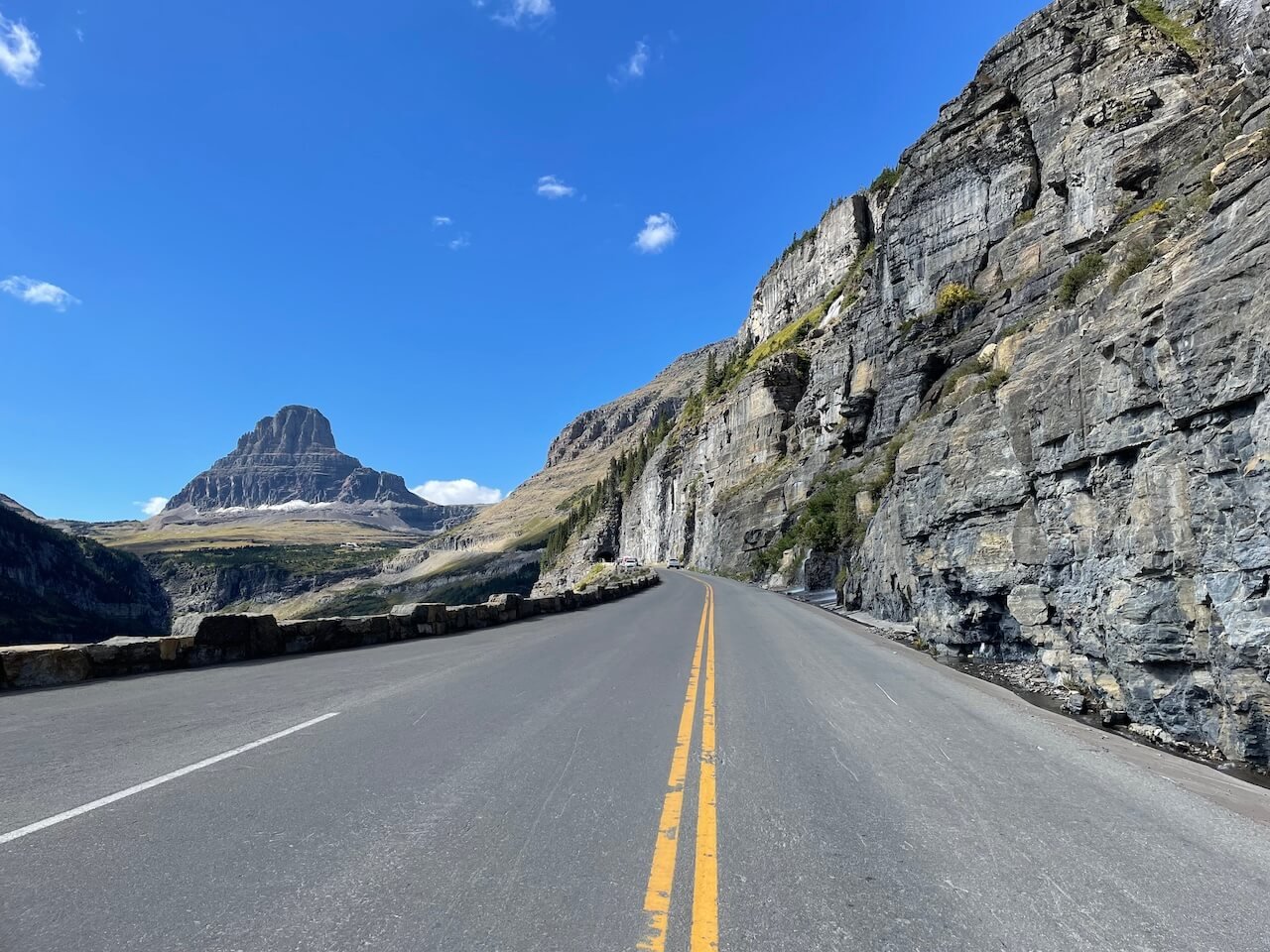Glacier’s Going-to-the-Sun Road: A Bucket List Scenic Drive
Going-to-the-Sun Road in Glacier National Park is widely considered to be one of the most breathtaking drives in the world. Winding through the heart of the Montana wilderness, this national park scenic drive offers close-up views of glacial valleys, alpine lakes, towering peaks, and cascading waterfalls, all from the comfort of your car.
If you’re planning a trip to Glacier, this drive belongs at the top of your list. In this guide, we’ll cover everything you need to know about driving Going-to-the-Sun Road, including the best stops, opening dates, shuttle options, drive times, and more tips for making the most of your journey.
What and Where is Going-to-the-Sun Road?
Going-to-the-Sun Road is in Montana’s Glacier National Park. It’s the park’s main scene drive, a 50-mile route that crosses the Continental Divide and takes you right through the park’s most incredible scenery. It connects the West Entrance near West Glacier and Apgar Village with the St. Mary Entrance on the east side.
Built in 1933, the road climbs up to Logan Pass (elevation 6,646 feet) and winds along cliffs, glacier-carved valleys, alpine meadows, and mountain peaks, with jaw-dropping views around every bend. If you’re visiting Glacier, this is the best way to see the park by car, and it’s a must-do for first-time visitors. (But truly… we’ve been to Glacier four times now, it’s a must during every visit!)
When is Going-to-the-Sun Road open?
Going-to-the-Sun Road is typically open in full from late June through mid-October, but exact dates depend on snow removal efforts. The upper portion of the road, including Logan Pass, is closed for most of the year due to heavy snowfall and avalanche risk.
✅ Lower sections (Lake McDonald and St. Mary) often open in May
✅ Logan Pass typically opens in late June or early July
❄️ Full road usually closes by mid-October (or earlier if snow hits)
Always check Glacier’s official road status page before your visit.
What’s the best direction to drive Going-to-the-Sun Road?
You can drive Going-to-the-Sun Road in either direction, but most people start on the west side in West Glacier and head east. This direction offers easier pull-off access, sweeping views of the Lake McDonald Valley, and a dramatic ascent up to Logan Pass. However, from late May through early September, you'll need a timed-entry vehicle reservation to access this section during the day.
If you don’t have a reservation, consider entering the park before 6 AM, after 3 PM, or using the park’s free shuttle system instead. You can also enter from the St. Mary Entrance on the east side, which doesn’t currently require reservations.
🎯 RTL Tip: We’ve driven Going-to-the-Sun Road many times in both directions, and honestly, you can’t go wrong either way. (We actually recommend doing a full roundtrip if you have time!) We tend to make more stops on the West Glacier side, but if we’re timing it for sunrise or sunset, we like driving East to West. Sunrise is especially beautiful near the East Entrance, while sunsets are pretty spectacular on the west side.
Map of Going-to-the-Sun Road
Going-to-the-Sun Road is packed with jaw-dropping views and photo-worthy stops, so having a good map on hand makes a big difference. We’ve learned that cell service is unreliable (or totally nonexistent) through much of the park (especially around Logan Pass and the east side) so it’s helpful to plan ahead.
We always recommend downloading an offline map in advance (Google Maps or Gaia GPS both work well) or grabbing a paper map from a visitor center before you begin your drive. It’s the easiest way to keep track of where you are, what’s ahead, and where you might want to pull over.
Some of the most iconic and can’t-miss stops along the route include:
Lake McDonald Lodge
Avalanche Creek and Trail of the Cedars
The Loop switchback
Logan Pass Visitor Center
Hidden Lake Overlook
Jackson Glacier Overlook
St. Mary Lake and Wild Goose Island
1-Day Going-to-the-Sun Road Itinerary
If you only have one day to explore Glacier by car, here’s a scenic drive itinerary that hits the major highlights. This is one of our favorite ways to spend a day in Glacier National Park!
Note: We’re sharing this itinerary from west to east for a few key reasons. First, the West Entrance is the park’s most popular starting point. It’s where most visitors enter, and it has more nearby lodging, services, and shuttle access. Starting here also helps you reach Avalanche Lake earlier in the day, when parking is more available. We recommend saving Logan Pass for later in the afternoon, when crowds thin out and you’ll have a better chance at a parking spot.
That said, if you’re planning around sunrise and sunset, you might want to drive east to west instead. Sunrise is especially beautiful near the East Entrance, and the west side tends to shine at golden hour. Just reverse the order of the stops below, and you’ll still see all the same highlights.
🚗 Start: West Glacier & Lake McDonald
Enter the park at West Glacier and begin your drive along the shores of Lake McDonald. Stop at Apgar Village for lake views or a kayak rental. Don’t miss the famous colorful pebbles along the lake’s shoreline… the vibrant reds, blues, greens, and purples are especially fun to see in the clear water near Apgar! Further up, Lake McDonald Lodge is a charming historic stop with trails and boat tours.
Stop 1: Avalanche Creek & Trail of the Cedars
This is a great early stop with a short, accessible loop through a forest of towering red cedars. You can also continue on to Avalanche Lake via a 4.5-mile roundtrip hike for turquoise waters surrounded by waterfalls. Fun fact: Avalance Lake is Jonathan’s favorite hike of all-time! The mountain lake views at the end are spectacular.
Avalanche Lake
Stop 2: The Loop
This sharp hairpin turn begins the dramatic climb up to Logan Pass. It's a good place to pull over and look back over the valley floor, especially at sunset.
Stop 3: Logan Pass & Hidden Lake Overlook
Logan Pass is the highest point on Going-to-the-Sun Road and one of the most scenic areas in Glacier. Several incredible hikes start here, including the popular Hidden Lake Overlook Trail, a 3-mile round trip hike along boardwalks and alpine meadows that offers panoramic views.
You can also hike part of the Highline Trail, which begins across the road and hugs the Garden Wall with nonstop views. (The first few miles to Haystack Pass are a great out-and-back option.) For more adventurous hikers, the full Highline Trail to The Loop is an epic one-way route, made easier with shuttle access.
Note: Parking at Logan Pass fills up fast—often before 8:30 AM during peak season. If you’re not planning an early start, consider taking the shuttle or arriving later in the afternoon when some spots start to open up as morning hikers leave.
Hidden Lake Overlook
Stop 4: Jackson Glacier Overlook
One of the few spots where you can see an actual glacier from the road. The viewpoint offers interpretive signage and a great photo op.
Stop 5: Wild Goose Island Overlook
One of the most iconic viewpoints in Glacier, this small island in the middle of St. Mary Lake is framed by dramatic peaks. Visit near sunrise for the best lighting.
Wild Goose Island Overlook
End: St. Mary Entrance (or return west)
From here, you can exit the park via the St. Mary Entrance or turn around and drive the route in reverse. If time allows, grab a meal at Rising Sun or in St. Mary, or head south on Highway 89 to explore Two Medicine or Many Glacier.
Driving Times Between Key Stops
Going-to-the-Sun Road stretches roughly 50 miles between West Glacier and St. Mary. Without stopping, the full drive takes about 2 hours one way. However, most visitors take longer as they pause for scenic overlooks, wildlife sightings, hikes, and parking at popular trailheads like Logan Pass.
With stops, expect the journey to take anywhere from 4 to 6 hours, or even more if you’re hiking or joining a guided tour. Here are some approximate drive times along Going-to-the-Sun Road (no stops):
Lake McDonald to Trail of the Cedars: 15 minutes
Trail of the Cedars (Avalance Lake Trailhead) to Logan Pass: 45 minutes
Logan Pass to Jackson Glacier Overlook: 15 minutes
Jackson Glacier to Wild Goose Island: 15 minutes
Going-to-the-Sun Shuttle System
Don’t want to worry about parking or vehicle reservations? Hop on Glacier’s free Going-to-the-Sun Shuttle. This service operates on both the west and east sides of the park, running daily from 8 AM to 7 PM during peak season. (Heads up: Taking a shuttle from the Apgar Visitor Center to the St. Mary Visitor Center, which is the entire length of Going-to-the-Sun Road—requires a shuttle transfer at Logan Pass.) Shuttles stop at all active shuttle stops along Going-to-the-Sun Road, including key areas like Apgar, Avalanche Creek, The Loop, Logan Pass, and St. Mary.
Shuttles are first-come, first-served and are a great option for hikers who want to be dropped off at one trailhead and picked up at another. The system connects many major trailheads and can help you avoid the stress of finding parking at popular spots like Logan Pass.
Red Bus Tours
If you'd prefer a narrated ride, consider one of Glacier’s iconic Red Bus Tours instead. These vintage open-roof vehicles have been offering narrated drives through Glacier since the 1930s. The tours are led by knowledgeable guides who share the park’s history, geology, wildlife, and fun stories along the way.
There are several tour options available, ranging from short trips to full-day excursions across Going-to-the-Sun Road. Some tours start on the west side of the park (West Glacier or Apgar), while others begin from the east (St. Mary or Many Glacier).
Why choose a Red Bus Tour?
No need to drive narrow roads or find parking
Great for photography thanks to roll-back canvas tops
Learn more through expert narration
Timed-entry reservation not required for riders
Heads up: Tours fill up fast in summer and advance reservations are highly recommended.
FAQs: Going-to-the-Sun Road
Q: Can you drive through Glacier National Park?
Yes! Glacier is incredibly scenic and very drivable. The main route through the park is Going-to-the-Sun Road, which stretches from West Glacier to St. Mary. It's the best way to experience the dramatic landscapes of the park in one day.
Q: Is it worth driving the Going-to-the-Sun Road?
Absolutely. If there’s one thing you do in Glacier, let it be this. It’s one of the most iconic drives in the U.S.—you’ll see snow-capped mountains, waterfalls tumbling down cliffs, deep green valleys, and maybe even a mountain goat.
Q: What does it cost to drive Going-to-the-Sun Road in Glacier National Park?
Driving Going-to-the-Sun Road is free, but you’ll need either an America the Beautiful Pass or a Glacier National Park entrance pass ($35 per vehicle, valid for 7 days). If you’re entering from the west during peak summer months (typically late May to early September), you’ll also need a timed-entry vehicle reservation. Entry reservations are $2 and booked through Recreation.gov.
Q: Do I need reservations to drive Going-to-the-Sun?
Partially. During peak season, you’ll need a timed-entry reservation in addition to your park pass if you’re entering via the west entrance. These go quickly, so book in advance!
You don’t need a reservation if:
You enter before 6 am or after 3 pm
You’re visiting outside of the reservation season (typically before late May or after early September)
You enter from the east side of the park via St. Mary
You have lodging, campground, or tour reservations that include entry access
Q: What if I can't get a vehicle reservation?
You’ve still got options. Enter the park before 6 AM or after 3 PM when timed-entry permits aren’t required. Or hop on the park’s free shuttle or book a Red Bus Tour, both of which offer access to the scenic route without needing a vehicle reservation. You can also enter via the East Entrance, which doesn’t currently require permits.
Q: Where does Going-to-the-Sun Road start and end?
The road begins at the West Glacier Entrance and ends at the St. Mary Entrance, or vice versa. Along the way, you'll pass Lake McDonald, Logan Pass, St. Mary Lake, and much more.
Q: How long does the Going-to-the-Sun Road take to drive?
Without stopping, about 2 hours one way. But you’ll want to plan at least 4 to 6 hours (or a full day) if you’re doing any hiking or stopping at overlooks, visitor centers, or for wildlife watching.
Q: What is the best time of year to drive through Glacier National Park?
Late June to mid-October, depending on snowfall. The road doesn’t fully open until all the snow is cleared, often around late June or early July, and it typically closes by mid-October due to early storms.
Q: What’s the speed limit on Going-to-the-Sun Road?
Speed limits are 40 mph in the lower elevations and 25 mph in the alpine section near Logan Pass. Go slow around curves and stay alert, as wildlife and pedestrians are common.
Q: Is the Going-to-the-Sun Road dog-friendly?
Not really. Pets are only allowed in developed areas and parking lots, and they must be on a leash at all times. They’re not allowed on trails or boardwalks, so if you’re planning to hike, it’s best to leave your furry friend behind. That said, dogs can absolutely join you for the drive. Our pup, Lincoln, has ridden with us on Going-to-the-Sun Road more than once, and she especially enjoys the windows-down parts.
Q: Can I drive an RV on Going-to-the-Sun Road?
Only if it's under 21 feet long and 8 feet wide (including mirrors). Anything larger isn’t allowed between Avalanche and Rising Sun due to the narrow, winding sections of the road.
Q: Can I ride a bike on Going-to-the-Sun Road?
Yes, but there are time restrictions. From late May through early September, bikes are not allowed on the section from Apgar to Logan Pass between 3 PM and 6 PM (in either direction).
Q: Is Going-to-the-Sun Road one-way?
No, it’s a two-way road. However, some sections are very narrow with no guardrails, so take it slow and yield to oncoming traffic when needed.
Q: Where can I eat or take a break along Going-to-the-Sun Road?
There aren’t many places to stop for food or supplies along the road, so it helps to know your options in advance:
Apgar Village: Quick bites, gear rental, gift shop
Lake McDonald Lodge: Full-service dining, snacks, restrooms, and lodging
Logan Pass: Restrooms and a small visitor center gift shop but no food service
Rising Sun & St. Mary: Snacks, gas, and a couple of restaurants or cafés
Q: Are there places to stay or camp along Going-to-the-Sun Road?
Five of the park’s thirteen campgrounds are located along Going-to-the-Sun Road: Apgar, Sprague Creek, Avalanche, Rising Sun, and St. Mary. Lodging is also available at Lake McDonald Lodge and Rising Sun Motor Inn during the summer.
Q: Where are the visitor centers along Going-to-the-Sun Road?
You’ll find three: Apgar (west), Logan Pass (center), and St. Mary (east). All offer restrooms, water, trip planning info, exhibits, and bookstores.
Q: What safety or seasonal conditions should I be aware of?
Going-to-the-Sun Road can be thrilling but also challenging. It’s not ideal for those with a fear of heights as some stretches hug the cliffside with no guardrails. The road is narrow and winding, especially near Logan Pass, where sudden weather changes are also common. Wildlife is frequently spotted near the roadside, including mountain goats, bighorn sheep, and even bears, so drive slowly and keep your eyes peeled.
Q: Are there other scenic areas in Glacier beyond Going-to-the-Sun Road?
Yes! Many Glacier, Two Medicine, and the North Fork offer incredible hiking, lakes, and wildlife viewing—often with fewer crowds.
Keep Planning Your Trip to Glacier National Park
Going-to-the-Sun Road is just the beginning. Extend your Glacier adventure with hikes to Grinnell Glacier, a boat ride on Lake McDonald, or a scenic drive to Two Medicine or Many Glacier.
Read Next:



















